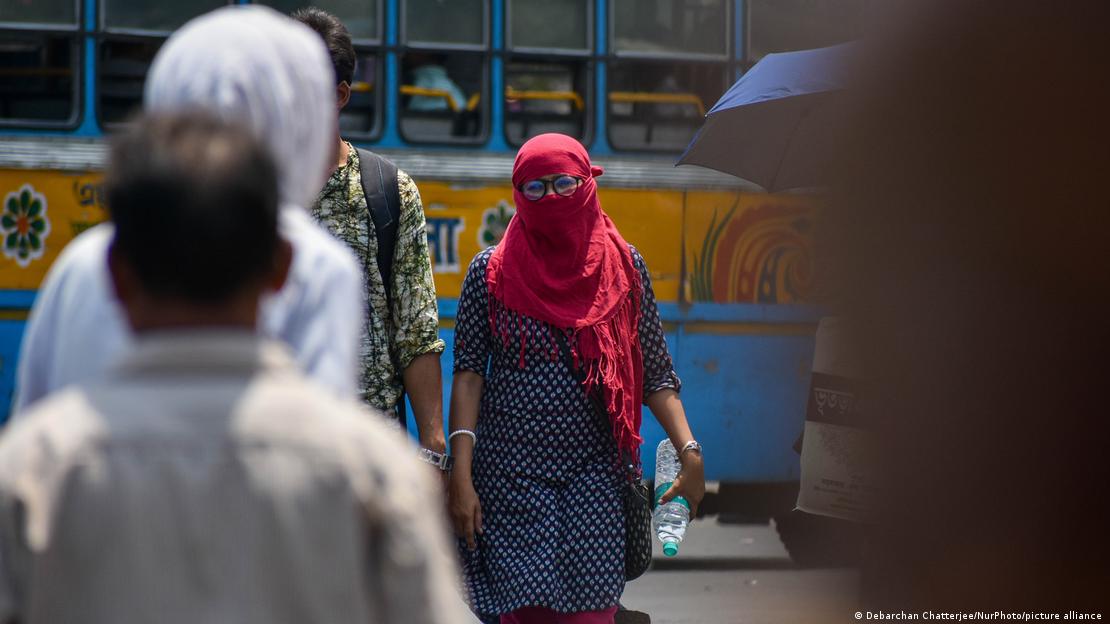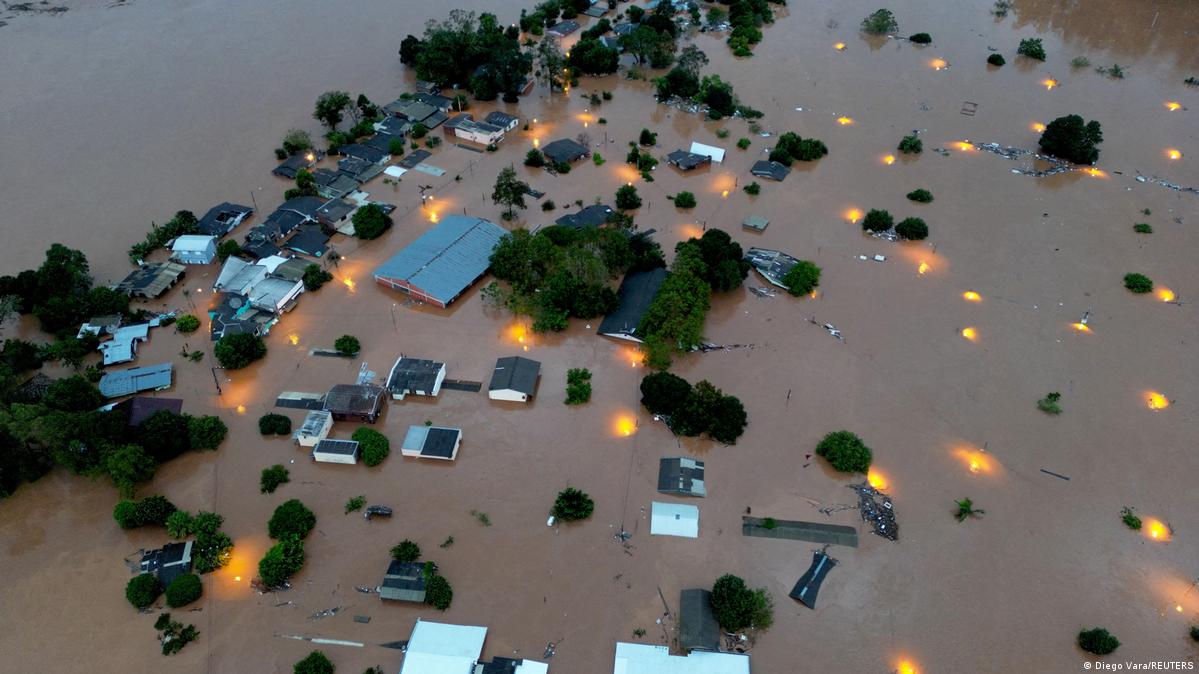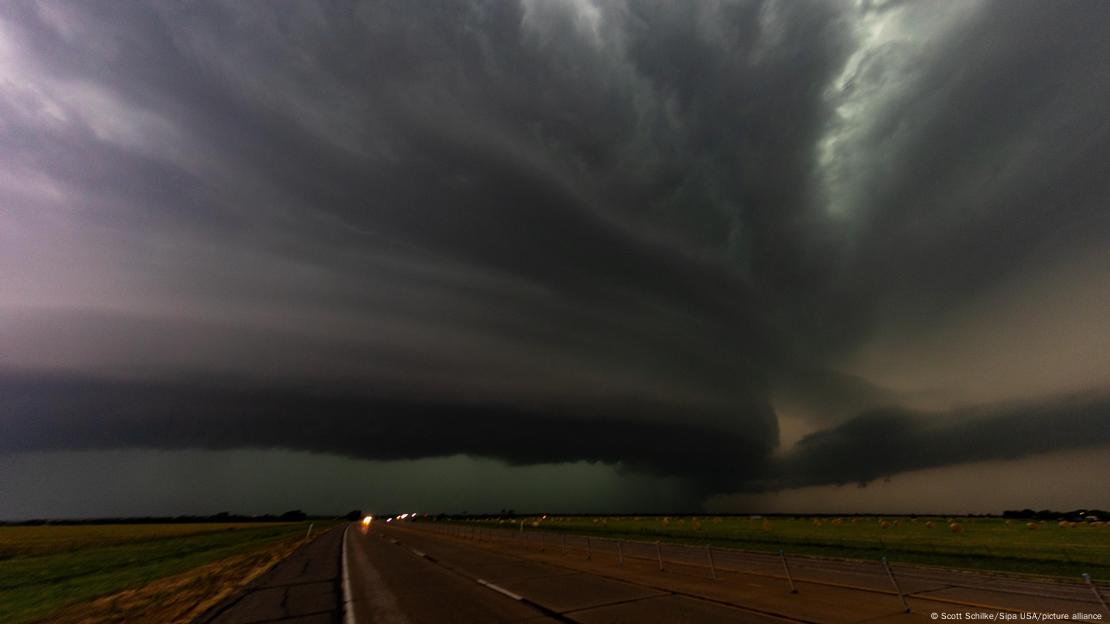DW
May 19, 2024
Climate change is fueling a surge in extreme weather events across the planet. It's a troubling sign of things to come.
Climate change is fueling a surge in extreme weather events across the planet. It's a troubling sign of things to come.
What is the link between climate change and flooding in Brazil?
Floods and heat waves across Africa, deluges in southern Brazil, drought in the Amazon and extreme heat across Asia, including India: the news has been full of alarming weather disaster stories this year, and for good reason.
So far, 2024 has been a particularly bad for extreme weather, according to the World Meteorological Organization (WMO), with droughts, extreme heat and floods causing severe damage to health and livelihoods.
"Almost every region in the world saw extreme weather and climate events of different natures," WMO climate expert Alvaro Silva told DW
And while not every individual extreme weather event can be attributed to climate change, they are becoming more likely and increasing in intensity due to the greenhouse emissions coming from burning coal, oil and gas.
Last year, the Northern Hemisphere had its hottest summer in the past 2,000 years, and globally, 2024 is on track to be even hotter.
What's the link between climate change and weather?
Climate change increases evaporation and puts more water vapor into the atmosphere. This causes more intense rainfall and flooding in some areas, and more extreme droughts in others. Warmer ocean temperatures intensify climate patterns, while higher overall temperatures lead to more frequent heat waves.
This plays havoc with global weather patterns, resulting in disparate effects across the planet.
"It's not only the frequency and intensity that you usually hear about, but it's also the changes in timing and duration of these extremes," said Silva. "We no longer know what is normal in the climate, because we see an increasing trend of extreme events."
What extreme weather is caused by climate change and what isn't?
The influence of climate change is apparent when looking at long-term weather trends, but determining its role in specific weather events has only recently become possible.
DW looked at three big weather events this year to see if climate change was a decisive factor.
Was there a link between climate change and the heat waves in India?
In April and continuing into May, India, along with many parts of Asia, suffered through a sweltering heat wave.
Parts of India experienced temperatures of 47 degrees Celsius (116 degrees Fahrenheit), leading to deaths and widespread misery. The heat wave has even called into question voter turnout in the world's largest democratic exercise, as India votes in protracted national elections.
Several politicians, election officials and campaign managers have reportedly fallen ill due the heat, including the federal roads minister who collapsed on stage.
"More than 900 billion voters need to go out in the outdoors and queue […] for hours and hours under the sun," said Leena Rikkila Tamang, Asia director of IDEA, a Sweden-based pro-democracy NGO. "We see a clear dip in voter turnout in comparison to the 2019 elections."

Floods and heat waves across Africa, deluges in southern Brazil, drought in the Amazon and extreme heat across Asia, including India: the news has been full of alarming weather disaster stories this year, and for good reason.
So far, 2024 has been a particularly bad for extreme weather, according to the World Meteorological Organization (WMO), with droughts, extreme heat and floods causing severe damage to health and livelihoods.
"Almost every region in the world saw extreme weather and climate events of different natures," WMO climate expert Alvaro Silva told DW
And while not every individual extreme weather event can be attributed to climate change, they are becoming more likely and increasing in intensity due to the greenhouse emissions coming from burning coal, oil and gas.
Last year, the Northern Hemisphere had its hottest summer in the past 2,000 years, and globally, 2024 is on track to be even hotter.
What's the link between climate change and weather?
Climate change increases evaporation and puts more water vapor into the atmosphere. This causes more intense rainfall and flooding in some areas, and more extreme droughts in others. Warmer ocean temperatures intensify climate patterns, while higher overall temperatures lead to more frequent heat waves.
This plays havoc with global weather patterns, resulting in disparate effects across the planet.
"It's not only the frequency and intensity that you usually hear about, but it's also the changes in timing and duration of these extremes," said Silva. "We no longer know what is normal in the climate, because we see an increasing trend of extreme events."
What extreme weather is caused by climate change and what isn't?
The influence of climate change is apparent when looking at long-term weather trends, but determining its role in specific weather events has only recently become possible.
DW looked at three big weather events this year to see if climate change was a decisive factor.
Was there a link between climate change and the heat waves in India?
In April and continuing into May, India, along with many parts of Asia, suffered through a sweltering heat wave.
Parts of India experienced temperatures of 47 degrees Celsius (116 degrees Fahrenheit), leading to deaths and widespread misery. The heat wave has even called into question voter turnout in the world's largest democratic exercise, as India votes in protracted national elections.
Several politicians, election officials and campaign managers have reportedly fallen ill due the heat, including the federal roads minister who collapsed on stage.
"More than 900 billion voters need to go out in the outdoors and queue […] for hours and hours under the sun," said Leena Rikkila Tamang, Asia director of IDEA, a Sweden-based pro-democracy NGO. "We see a clear dip in voter turnout in comparison to the 2019 elections."

Parts of India hit a sweltering 47 degrees Celsius in recent weeks
Image: Debarchan Chatterjee/NurPhoto/picture alliance
The heat wave in India was 45 times more likely due to climate change and was 0.85 degrees Celsius hotter than it otherwise would have been, according to the World Weather Attribution (WWA). The WWA is an initiative of scientists investigating whether and to what extent human-induced climate change has played a role in recent extreme weather events.
"There is absolutely no doubt that as long as we continue to burn fossil fuels and, therefore, increase the concentration of greenhouse gases in the atmosphere, these heat waves will become more frequent, more severe, and longer in their duration," Friederike Otto, who leads the organization, told DW.
The damage caused by extreme weather depends on the vulnerability of the population. Even a seemingly small temperature increase can cause major harm.
"In countries like India and other parts of South Asia, where lots and lots of people are working outdoors, they are much more exposed and more vulnerable to even relatively small changes in extreme heat," said Otto.
The heat wave in India was 45 times more likely due to climate change and was 0.85 degrees Celsius hotter than it otherwise would have been, according to the World Weather Attribution (WWA). The WWA is an initiative of scientists investigating whether and to what extent human-induced climate change has played a role in recent extreme weather events.
"There is absolutely no doubt that as long as we continue to burn fossil fuels and, therefore, increase the concentration of greenhouse gases in the atmosphere, these heat waves will become more frequent, more severe, and longer in their duration," Friederike Otto, who leads the organization, told DW.
The damage caused by extreme weather depends on the vulnerability of the population. Even a seemingly small temperature increase can cause major harm.
"In countries like India and other parts of South Asia, where lots and lots of people are working outdoors, they are much more exposed and more vulnerable to even relatively small changes in extreme heat," said Otto.
Did climate change play a role in the Brazil floods?
More than 100 people have died so far in severe floods in the southern Brazilian state of Rio Grande do Sul, which has also caused billions of dollars of damage.
Almost 1.5 million people have been displaced, in what is reported to be the biggest case of climate migration in the country. The state government is even considering moving entire cities to avoid future catastrophes.
Brazil: Dozens dead in severe flooding
Severe flooding in southern Brazil has killed dozens and forced tens of thousands to leave their homes. Aid is proving difficult, and the governor has called it a "historic disaster".Image: Diego Vara/REUTERS

Submerged in water
Only the roofs of these houses in the southern Brazilian state of Rio Grande do Sul are still sticking out of the water. Severe storms have been raging in the region since Monday, causing flooding. At least 56 people have died in the floods so far, officials said on Saturday. Scores remain missing, so the number of victims could still rise.Image: Diego Vara/REUTERS

Hundreds of thousands affected
Those affected are literally up to their necks in water. The heavy rain has flooded entire regions and thousands have had to leave their homes. According to reports, around 320,000 homes currently have no electricity and more than half a million households are cut off from their drinking water supply. The authorities have declared a state of disaster.Image: Diego Vara/REUTERS
Some scientists have already pointed to the effects of climate change, on top of ongoing warming from El Nino, to explain the floods.
One study, published by the French group Laboratoire des Sciences du Climat et de l'Environnement [Climate and Environment Sciences Laboratory], found the heavy rainfall that led to flooding could mostly be ascribed to human-driven climate change.
WWA is working on its own study, but Otto said previous floods in the country were clearly linked to climate change.
Vulnerability also plays a highly significant role in the damage caused by floods, with some engineers pointing to a lack of preparedness and infrastructure issues.
Did climate change make the recent glut of tornadoes in the US worse?
The US has been buffeted by an high number of tornadoes this year.
Over a period of four days, more than 100 tornadoes hit the Midwest and the Great Plains, "causing significant damage and loss of life," said officials.
The National Weather Service in Omaha, Nebraska, set a record by issuing 48 tornado warnings in a single day.
Those affected are literally up to their necks in water. The heavy rain has flooded entire regions and thousands have had to leave their homes. According to reports, around 320,000 homes currently have no electricity and more than half a million households are cut off from their drinking water supply. The authorities have declared a state of disaster.Image: Diego Vara/REUTERS
Some scientists have already pointed to the effects of climate change, on top of ongoing warming from El Nino, to explain the floods.
One study, published by the French group Laboratoire des Sciences du Climat et de l'Environnement [Climate and Environment Sciences Laboratory], found the heavy rainfall that led to flooding could mostly be ascribed to human-driven climate change.
WWA is working on its own study, but Otto said previous floods in the country were clearly linked to climate change.
Vulnerability also plays a highly significant role in the damage caused by floods, with some engineers pointing to a lack of preparedness and infrastructure issues.
Did climate change make the recent glut of tornadoes in the US worse?
The US has been buffeted by an high number of tornadoes this year.
Over a period of four days, more than 100 tornadoes hit the Midwest and the Great Plains, "causing significant damage and loss of life," said officials.
The National Weather Service in Omaha, Nebraska, set a record by issuing 48 tornado warnings in a single day.
But the causes of tornadoes are incredibly hard to pin down, because they are so localized. Climate change attribution studies work best on large-scale events over big areas, such as heat and cold extremes, and droughts.
With the exception of tropical cyclones in the North Atlantic, climate change has not been linked to increased wind speeds, especially over land, according to Otto.
"Given that we don't see changes in other kinds of wind speeds or other kinds of storms, I wouldn't expect to see a huge change, but that might be quite different for tornadoes because they are also a different phenomenon," she said.
Essentially, scientists can't say what kind of role climate change played, or if it did at all.

The US was hit with more than 100 tornadoes over a few days in AprilImage: Scott Schilke/Sipa USA/picture alliance
Hasn't extreme weather always happened?
History is awash with examples of extreme weather, even before the cogs of the Industrial Revolution began turning and humans started burning the fossil fuels responsible for climate change in earnest. Such events are natural phenomena, but climate change has very clearly made them far more likely and destructive, say experts.
Before the 1990s, about 70 to 150 weather and water-related hazards were reported per year. Since 2000, 300 extreme events have been registered annually. Even with underreporting in the past, "the difference is unquestionable," said WMO's Alvaro Silva.
Edited by: Jennifer Collins


























